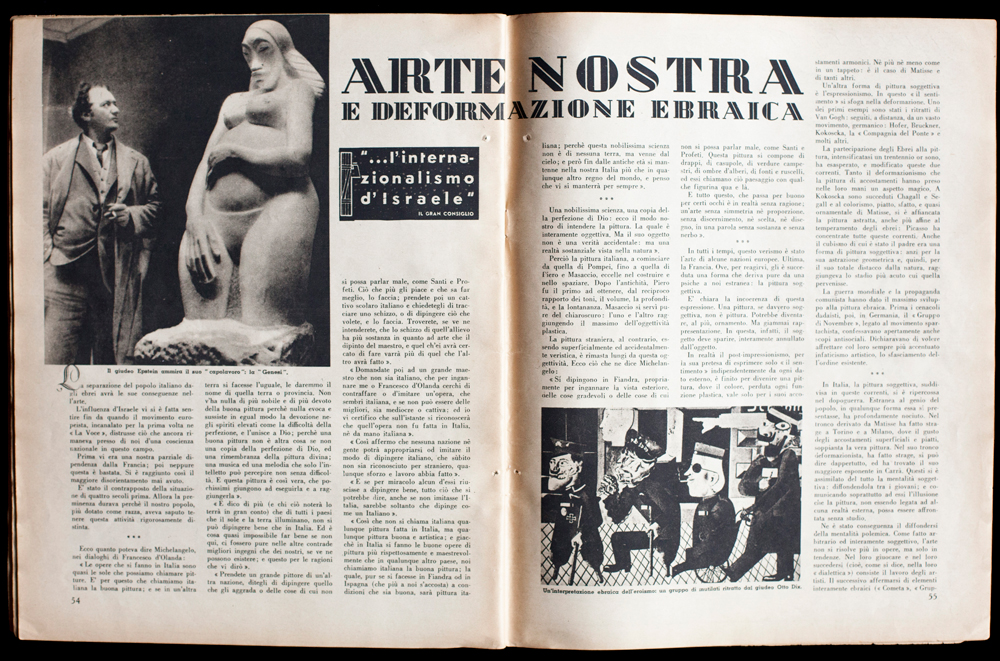Propaganda Degenerata L’arte tra persecuzione e propaganda
Degenerated Propaganda Art between persecution and propaganda
- Latest Writings, Writings
// Year:
2016
// Reprint:
2022
// Publications:
First edition: Media-Archive Notebooks #1, Historical Exhibitions, January 2016
Second edition: Media-Archive Notebooks #1, Historical Exhibitions, November 2016
Third edition: Media-Archive History | Degenerated Propaganda – The Art between persecution and propaganda from the Diego Cinquegrana Collection, January 2022
// Author:
Diego Cinquegrana
// Details:
Short essay for the exhibition ‘Degenerated Propaganda’ held at Comune di Bisuschio (Varese) from 16.01.2016 to 05.02.2016, on the occasion of the Holocaust Memorial Day 2016. Under the patronage of: Comune di Bisuschio, Comunità Ebraica di Milano, Comunità Ebraica di Napoli.
// Credits:
© 2016 – 2022 Diego Cinquegrana | Media-Archive History – All rights reserved | thegoldentorch.com

“Degenerate” means to be corrupt, to take a non-generative, outside gender and destructive road.
Between the second half of the ‘800 and the end of the ‘30s, “degenerate” was first of all refered to what was far away (in terms of appearance and race, in the “form” and “substance”) from the “pure” Germanic tradition and later from that of the Nazis.
The biological degeneration of the individual led to the stigmatization of the Untermensch: imperfect, menacing and horrific enemy of the Übermensch or the so called ‘’Aryan”, not degenerated and noble individual that meets the absurd canons of the racial Renaissance advocated from fascism. To represent a strong and measured body, with an eye to the future, armed with sword and surrounded by a mantle inflated by the wind is “Übermensch”; in contrast, the dream dimension of Chagall and the Cubist intuition of Cézanne is necessarily “Untermensch” because it does not meet the aesthetic criteria mentioned above.
To paraphrase an italian antisemitic slogan from the ‘40s that wanted (wrongly) define Chaplin “Jew” twice, one for the alleged Jewish origin and one for his alter ego Charlot, even “degenerate” arte was the result of the destructive will of the Jew therefore the work “Purim” Chagall was “Jewish twice”. In 1937, two years after the Nuremberg Laws (a particularly prolific year of “documentary” exhibitions in Nazi Germany), was inaugurated the exhibition or the J’accuse, “Entartete Kunst” where the term “Entar- tete” (borrowed from anti-modernist thinking of the critic of Jewish origin Max Nordau) became the leitmotiv of the pathological deviance of all that art which today is part of the wonderful human cultural heritage, but which at the time was little more than a barbaric expression of deviance and that the same Göbbels rejoiced auction to sell off in order to “[…] earn some money from that garbage.”
Today the taste makes us choose one thing over another for affinity, common sense makes us aware of the respect of the differen- ces, intelligence enables us to grasp the beauty and usefulness of the things in order that, in the flow of events , everything finds its place in a constructive and generative point of view. In 1937, fascism adopted arbitrary criteria of selection, both on individuals and on their work, by imposing a “race” and therefore only one unique representation of the same, denigrating and eliminating what does not conform to the expression of his aesthetic and biological ideology and finally sterilizing what more than anything else it does not lay down any clothes except its only need to exist: the emotion. The Dutchman Rembrandt did not know that centuries after his death, the material light of his paintings would have inflamed the hearts of “Sonnenmenschen” Aryan-Germanic and would be elected from among the standard-bearer of the right art; German Nolde however, even if joined the Nazi party from the first hour and awarded prestigious academic positions will not have the same honor, because of the strong drama of his figu- ration and primitivism of his art viewed as corruption and subversion instead of avantgarde and sometimes prophetic. It was the summer of 1937 when millions of visitors could watch what was surely the largest retrospective of the century: “Entartete Kunst”, was certainly an excellent opportunity to admire the undisputed masterpieces of modern art, but it was also a sad stage of the Nazi politic; Psychopathen, Juden und Judenfreunden, (psychopaths, Jews and friends of Jews) are just some of the “elegant” adjectives that were offered to spectators in the tragicomic seriousness of the anti-Jewish propaganda that accompanied the exhibition, counterpart of slogans such as: Kraft und Schönheit sind die dieses Fanfaren Zeitalters, (strength and beauty are the fanfare this time) paradoxical statements wet by the ink of the infamous cartoons of Fips, lucky antisemitic pencil of Der Stürmer.
“Entartete Kunst” became like many a traveling exhibition since all the Reich had to see and feel disgust (or do business as evi- denced by findings of many masterpieces in attics and basements of former collaborators of the Reich). The seeds of “modernist Jewish subversion” (and others) will leave the witness to another infamous exhibition opened near the end of “Entartete Kunst”. The documentary exhibition Der Ewige Jude reiterated the concept, with a public success less than the previous exhibition, but still significant (more than 5,000 visitors a day) and also extended the attacks to the protagonists of the art world (as well as political and economic) of Jewish origin as Mahler, Mendelssohn and many others; each exposure produced hundreds of souvenir propa- ganda, now become objects of study and collecting and witnesses of the absurdity of Nazi-fascism and his epilogue.
Also the seventh art dressed the brown shirt and since 1940 also the celluloid served the propaganda: Der Ewige Jude was also the title of an alleged anti-Semitic documentary directed by Fritz Hippler: 62 minutes of suffocating anti-Jewish propaganda where the juxtaposition of elements maliciously chosen “had” somehow to exorcise the undaunted Aryan from bacillus Judaizing. At the opening of the movie camera shows (perhaps for the last time) the faces of Polish Jews busy in their daily lives and about half of the movie, a roundup of “famous” Jews, also fits that Kurt Gerron, director and actor , that from the light of the set next to Marlene Dietrich will knows the darkness of Theresienstadt and his death in Auschwitz.
And what happened in Italy? Nothing is easier than to recieve by the nazis news agencies a few photos already used and strike up an article on the ridicolous headline of “La Difesa della Razza” as well, the number 6 of year 1, the fateful 1938, we read a script of the architect Giuseppe Pensabene titled “Arte Nostra e Deformazione Ebraica” where subjectivity in painting is called “alien”, where Matisse is “flat like a carpet”, the “Die Brücke” is reduced to a mass of psychotic and which states that: “Jewish participation has exasperated and perverted the current […] gave something magical […] World War and the Communist propaganda did their best development to Jewish painting […] Jewish influence has destroyed architecture as art by reducing it to an economic fact, by aban- doning the neoclassical to the modernist functionalism, not only losing the sense of tradition but even worse that of the race.” The planetarium of the allegations of corruption and Judaizing of Italian art was extremely rich and varied, full of colorful expressions for each of the seven arts as “the deadly bacillus of the international Jewish music”. Hard to even pronounce the combination race and art, in light of what would happen to a few years and must have seemed as strange and shameful his adopted land between 1938 and 1943 to Emma Goitein Dessau, German artist of noble Jewish origin, author of delicate portraits and refined symbolist woodcuts, driven underground in the city of Perugia where he lived for years with her husband, Prof. Bernardo Dessau, director of the Institute of Physics of the University of Perugia.
The memory of what happened (and happens even today) not only wants to be renewed through the commemoration but expecially wants to be understood as a treasure trove of knowledge, art and life.
The collection
A small preview of some of the objects contained in the collection. The entire collection is published in the volume: Degenerated Propaganda, the Art between persecution and propaganda – Documents from the Diego Cinquegrana Collection on Antisemitism, Media-Archive History, 2022.
